Cross Stitch Academy
How to match number of strands to canvas density
Article for: beginners and intermediate users
Author: Grzegorz Zochowski
Authoress of cross-stitch: Joanna Marcinkowska
The article contains a clue and an illustration - what you may expect when you cross-stitch with a given number of strands on canvases of various density.
VOCABULARY:
INTRODUCTION
A very frequent question concerns the number of strands used to cross stitch on a given canvas. If the number of strands is too small, it will be possible to see canvas between the crosses. If it is too large, cross stitching will be hindered, cost - higher and the result - worse than it could be if the thread thickness was correctly adjusted.
The author's personal opinion is that if the pattern is illustrative, it presents something specific, it will be better to adjust the number of strands so that they thoroughly cover the space under cross-stitch. If you make patterns, ornaments or other simple decoration which are supposed to add attractiveness to something bigger, the effect will often be better when the number of strands is smaller so that a "cross" is clearly discernible due to the visible canvas or linen underneath. The final decision is to be made by a stitcher.
For the needs of this guide, test patterns have been cross-stitched on 8 canvas of various count. The task was to cross-stitch 6 squares of 10x10 crosses with various number of strands. If it was too difficult but still feasible, the squares were of 5x5 crosses. If the difficulty was too high, cross-stitching was abandoned.
CANVAS DENSITY (count)
The table contains calculations of counts between crosses per 10 cm and crosses per inch, and the canvases used in the experiment are distinguished. If you are looking for a photo how a cross-stitch would look like on canvas of count other than the distinguished ones, look for the ones which are the closest the one you have - of higher and lower density. At the same time, as a curiosity, the precision of canvas production was controlled.
Legend:
12 - canvas density as given by the manufacturer (click to see photos of the canvas)
12 - calculated canvas density
| Canvas density (count) calculator | |||
|
Density (count) [crosses per inch, ct, cpt] |
Density (count) [crosses per 10 cm] |
Cross size [mm] |
Value measured [crosses per 10 cm] |
| 6,5 | 26 | 3,91 | |
| 7 | 28 | 3,63 | |
| 8,64 | 34 | 3,4 | 34 |
| 10 | 39 | 2,54 | |
| 11 | 43 | 2,3 | 45,5 |
| 12 | 47 | 2,12 | |
| 13 | 51 | 1,95 | |
| 14 | 55 | 1,81 | 53 |
| 15 | 59 | 1,69 | |
| 16 | 63 | 1,59 | 63,5 |
| 17 | 67 | 1,49 | |
| 18 | 71 | 1,41 | 70 |
| 19 | 75 | 1,34 | |
| 20 | 79 | 1,27 | 78 |
| 22 | 87 | 1,154 | 89,5 |
| 25 | 98 | 1,016 | 100 |
TEST CROSS-STITCH
| Canvas 8.6 crosses per inch (~34 crosses per 10 cm) | |
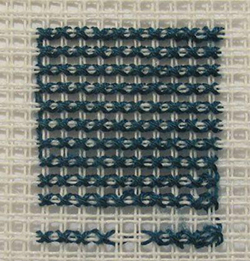 1 strand |
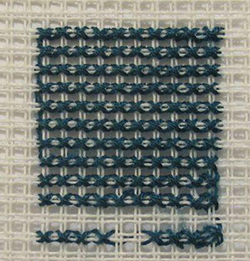 2 strands |
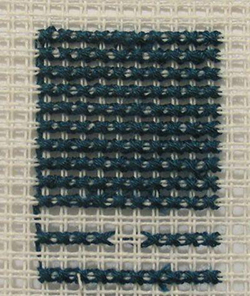 3 strands |
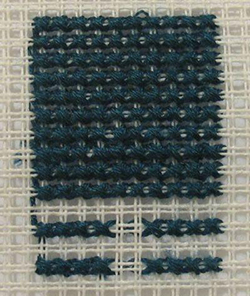 4 strands |
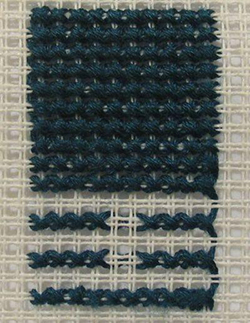 5 strands |
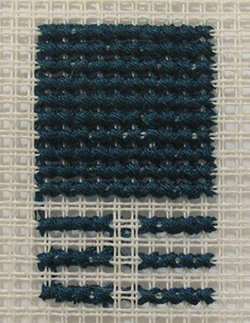 6 strands |
| Canvas 11 crosses per inch (~43 crosses per 10 cm) | |
 1 strand |
 2 strands |
 3 strands |
 4 strands |
 5 strands |
 6 strands |
| Canvas 14 crosses per inch (~55 crosses per 10 cm) | |
 1 strand |
 2 strands |
 3 strands |
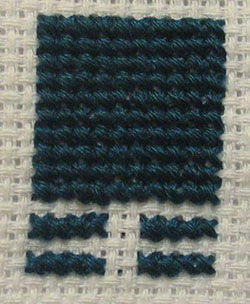 4 strands |
 5 strands |
 6 strands |
| Canvas 16 crosses per inch (~63 crosses per 10 cm) | |
 1 strand |
 2 strands |
 3 strands |
 4 strands |
 5 strands |
6 strands - too dense |
| Canvas 18 crosses per inch (~71 crosses 10 cm) | |
 1 strand |
 2 strands |
 3 strands |
 4 strands |
|
5 strands - too dense |
6 strands - too dense |
| Canvas 20 crosses per inch (~79 crosses 10 cm) | |
 1 strand |
 2 strands |
 3 strands |
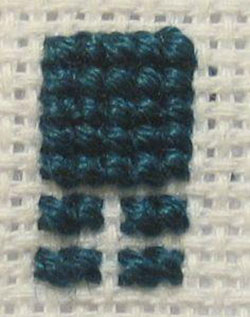 4 strands |
|
5 strands - too dense |
6 strands - too dense |
| Canvas 22 crosses per inch (~87 crosses 10 cm) | |
 1 strand |
 2 strands |
 3 strands |
 4 strands |
|
5 strands - too dense |
6 strands - too dense |
| Canvas 25 crosses per inch (~98 crosses 10 cm) | |
 1 strand |
 2 strands |
 3 strands |
4 strands - too dense |
|
5 strands - too dense |
6 strands - too dense |